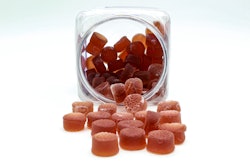A frequent complaint from operating room personnel was that it was difficult to know exactly how to open sterile medical packages. Many felt that the structural indicators weren't in place to make opening intuitive. Further, they found it frustrating to have only one opening option.
In addition to slowing down the process, the concern was that attempting to open a package incorrectly could compromise the sterility of the contents-particularly with header bags where the access area is not at the end of the structure, making sterile removal more challenging.
The Duet peelable chevron header pouch addresses those concerns and provides sterile medical product makers with a new alternative designed to improve functionality and reduce costs compared with traditional header bags and chevron peel pouches. Duet's new hybrid design combines elements from both header bags and chevron pouches. It reduces the amount of Tyvek® typically found on a chevron pouch by borrowing the "header" concept from the bag, thereby removing cost. A strip of Tyvek® is heat-sealed to a polyester/extrusion-coated sealant to create one side of the structure. (Tyvek® is typically used when ethylene oxide is the sterilization method.)
The next step is to three-side, heat-seal the Tyvek®/film combination to a layer of polyester/poly. (The top Tyvek® area is left unsealed so that the medical product can be loaded later.) At the bottom, the polyester/extrusion-coated layer extends slightly beyond the polyester/poly film side creating access tabs at both corners where a dual chevron opening feature has been created.
The pouch is sent to the sterile medical packager with the chevron or bottom access seals already in place. The device or kit is loaded from the top end where the Tyvek® and film are heat-sealed. (This is different from header-bag structures that are loaded from the film-to-film end and accessed via a fold-over, peelable heat-seal-coated Tyvek® flap. Traditional chevron pouch structures typically rely on a full layer of Tyvek® sealed to polyester/poly.)
The dual chevron at the outer edge of the structure aims to make it easier for operating room personnel to open and remove challenging three-dimensional geometries-such as trays, tubing, and various kits-without flaps potentially compromising the aseptic presentation.
In addition to slowing down the process, the concern was that attempting to open a package incorrectly could compromise the sterility of the contents-particularly with header bags where the access area is not at the end of the structure, making sterile removal more challenging.
The Duet peelable chevron header pouch addresses those concerns and provides sterile medical product makers with a new alternative designed to improve functionality and reduce costs compared with traditional header bags and chevron peel pouches. Duet's new hybrid design combines elements from both header bags and chevron pouches. It reduces the amount of Tyvek® typically found on a chevron pouch by borrowing the "header" concept from the bag, thereby removing cost. A strip of Tyvek® is heat-sealed to a polyester/extrusion-coated sealant to create one side of the structure. (Tyvek® is typically used when ethylene oxide is the sterilization method.)
The next step is to three-side, heat-seal the Tyvek®/film combination to a layer of polyester/poly. (The top Tyvek® area is left unsealed so that the medical product can be loaded later.) At the bottom, the polyester/extrusion-coated layer extends slightly beyond the polyester/poly film side creating access tabs at both corners where a dual chevron opening feature has been created.
The pouch is sent to the sterile medical packager with the chevron or bottom access seals already in place. The device or kit is loaded from the top end where the Tyvek® and film are heat-sealed. (This is different from header-bag structures that are loaded from the film-to-film end and accessed via a fold-over, peelable heat-seal-coated Tyvek® flap. Traditional chevron pouch structures typically rely on a full layer of Tyvek® sealed to polyester/poly.)
The dual chevron at the outer edge of the structure aims to make it easier for operating room personnel to open and remove challenging three-dimensional geometries-such as trays, tubing, and various kits-without flaps potentially compromising the aseptic presentation.
















